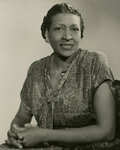

A new exhibit at Historic Germantown will take visitors on a journey through the neighborhood’s 1940s past – and highlight two female luminaries whose life work had an enormous impact in the city and beyond.
"Inspiring Bright April: Race and Class in 1940s Germantown" is based on Marguerite de Angeli's beloved 1946 book, "Bright April," which tells the story of a 10-year-old African American Brownie scout. The exhibit opens May 13 with a free family day at the Germantown Historical Society, headquarters for Historic Germantown.
De Angeli's novel, one of the early efforts to promote multiculturalism and inclusivity in children's literature, depicts April's journey as she learns to navigate various difficult experiences in which she faces racial prejudice, ultimately growing in strength and character. "Bright April" quickly became a favorite among young Black girls in that era, and was groundbreaking in its time, as few children's books of that era featured characters from diverse backgrounds.
The show explores Germantown’s history, its reflection in de Angeli’s work and how the community evolved over the decades. Exhibit's creators, Barbara Dowdall, Becky Birtha, and Susan Bockius will lead a short presentation at 3 p.m. during opening-day events. They will discuss the origins of "Bright April," the significance of the book to young African American girls in the 1940s and 1950s, and the portrayal of the Black family at the center of the book.
The exhibit will also explore how Newberry Award-winner de Angeli, a white author residing in Mt. Airy, came to understand and represent the African American community in her writing. Was her description of a Black family of the 1940s correct? What other literature was published in that era focusing on Black children? And, what is the status of Black children’s literature today? Visitors will learn about the cultural landscape of the period, as well as how children's literature featuring Black protagonists has evolved over the years.
De Angeli, who was also an accomplished singer, had a large family – her husband, John Shadrach de Angeli, and eventually six children. After living in many locations in the American and Canadian West, the family settled in the Philadelphia area, where they lived in various different neighborhoods. It was in 1921 that she began to study drawing under her mentor, Maurice Bower. By 1922 she was illustrating a Sunday School paper and later went on to illustrate many books as well as various well-known magazines, including The Country Gentleman, Ladies' Home Journal, and The American Girl.
The exhibit also examines an important friendship, and connection, between de Angeli and Nellie Bright, an African American principal of the Joseph E. Hill School on West Rittenhouse Street.
Bright, who was part of a Philadelphia literary group the Black Opals that published a magazine of the same name, had a significant impact on the Germantown and Mt. Airy African American communities during the 1940s. Like similar groups in other east coast cities, the Black Opals were considered an extension of the Harlem Renaissance.
In addition to her work in education, Bright was also an active civil rights advocate and community leader. She was involved in numerous organizations that promoted social change and fought for equal opportunities for African Americans.
Bright and her family were part of the Great Migration, having moved from Savannah, Ga., to Philadelphia when she was 12. She eventually studied at the University of Pennsylvania, where she became a founding member of the Gamma chapter of the university’s first Black sorority, Delta Sigma Theta. She also studied at the Sorbonne and University of Oxford, University of Vermont and at the Berkshire School of Art in Massachusetts. And she, too, was a writer - co-authoring the book “American – Red, White, Black, Yellow,” which focuses on the history of minorities in the United States, with her longtime colleague Arthur Fauset.
Attendees will also gain insight into the history of Brownie scouts, including the evolution of their uniforms and how they've changed since the 1940s. Children’s activities will also be part of the opening event.
The exhibit is a presentation of the Historic Germantown consortium, a collaboration of 18 historic houses, destinations, and museums in Northwest Philadelphia. The institutions work together to protect, preserve, and share some of the city's cultural assets.
The May 13 opening event will be 11 a.m. to 5 p.m. at 5501 Germantown Avenue. Refreshments will be served. For more information on the exhibit or the grand opening, contact Caitlin at programs@freedomsbackyard.com.